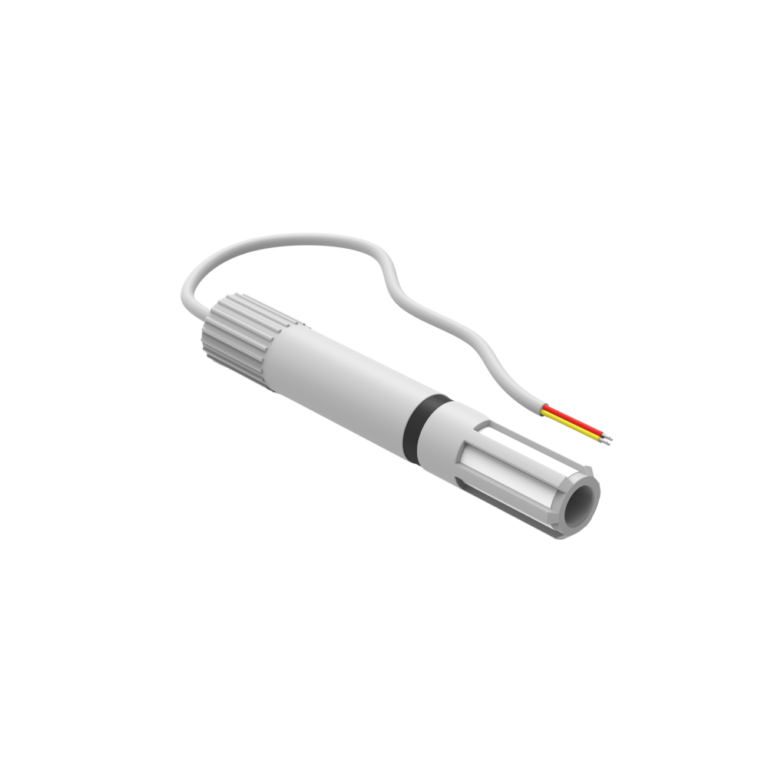Humidity sensors
- Allmetra AG
- Products & Production
- Humidity sensors
For many products of the food processing, agriculture, paper, cardboard and textile industries and others, moisture content is an important measure of quality, productivity and economic efficiency. Terms such as material humidity, residual humidity, or water content play an important role in numerous drying, conditioning and storage processes. We offer humidity sensors with different specifications for a wide variety of applications.
Models:
- Temperature and humidity sensors with a head
- Multifunctional indoor air quality monitors
- Indoor temperature and humidity transmitters
- Probe types
- Industrial humidity sensors
- Wall types
Specifications:
- -40 °C to +180 °C
- 0 to 100% humidity
Types of application:
- Measurement of the humidity of materials in paper, cardboard and can production
- Measurement of air humidity
- Measurement of soil moisture in tensiometers
- Control of an indoor climate
- Monitoring of working conditions
- Quality measurement of grain
Areas of application:
- Food
- Textiles
- Paper
- Agriculture
- Electronics and semiconductors
- Medical technology
Due to their diverse fields of application, sensors to measure the moisture in solid materials can be constructed using a variety of measurement principles. These include, for example:
- Capacitive measurement
- Conductivity measurement
- Microwave process
- Infrared reflection
This is an indirect humidity measurement method. This means that the moisture content is not determined directly, but via another physical property that allows conclusions to be drawn about the water present.
Capacitive humidity measurement is based on the functional principle of a capacitor. For these sensors, a moisture-sensitive polymer layer is located on a glass substrate between two metal layers (capacitor plates). If moisture acts on this, the dielectric constant changes and with it the capacitance of the capacitor.
With the conductivity method, material humidity is measured by determining the electrical resistance. This depends on the moisture content of the medium to be analyzed. Microwave methods use the differences between the relative dielectric constant of water and that of the material to determine the humidity. In contrast, infrared reflection methods make use of the fact that the amount of light reflected changes at certain wavelengths depending on the water content of the material.
Sensors for measuring air humidity can be classified according to the following humidity parameters:
- Absolute humidity (weight of the water vapor in a cubic meter of mixed air-water vapor)
- Relative humidity (ratio of the water vapor content of the air to the maximum possible water vapor content at the same temperature)
- Enthalpy (heat content of moist air)
- Mix ratio (absolute humidity based on one kilogram of dry air)
- Saturation vapor pressure (maximum possible water vapor pressure at a certain temperature)
- Dew point (temperature at which the relative humidity is 100%)
- Water vapor partial pressure (proportion of air pressure in the room determined exclusively by water vapor)
The ability to control the moisture content of solids or the environment is indispensable in many areas today. We can provide you with precise humidity sensors that meet a wide variety of requirements.
Our portfolio includes:
- Temperature and humidity sensors with a head
- Multifunctional indoor air quality monitors
- Temperature and humidity transmitters
- Industrial humidity sensors
The devices can be specified to measure humidity ranges from 0 to 100 percent and temperatures from -40 °C to +180 °C.
Allmetra humidity sensors are at home in a wide variety of industries. The most important fields of application include the following industries:
- Food
- Paper
- Textiles
- Agriculture
- Medical technology
- Electronics and semiconductors
Whether you want to measure the humidity of materials in paper, cardboard or can production, monitor working conditions, or determine the soil moisture in tensiometers, our high-quality moisture sensors position you ideally. You can also check grain quality with our devices, as well as measure air humidity and control an indoor climate based on this.
Are you looking for a tailor-made solution for humidity measurement? We would be happy to adapt our sensors exactly to your requirements. Simply contact us for a personal consultation. Thanks to our global sales network, we are always available to you, and ensure on-site delivery via fast, worldwide airfreight.
Allmetra’s measurement chain
Products & Production
During our decades of experience, we have found the perfect balance between in-house production and using our partners’ plants. Always with the aim of delighting our customers with the best possible solutions.
Accessories & Components
We have built true partnerships with our suppliers through our many years of doing business together. We only work with quality-conscious, highly qualified suppliers.
Services & Solutions
We keep an eye constantly on the future, which we see filled with expert advice, technical support, and developments ranging from a wide array of sensors up to customized IoT / IIoT software solutions.




